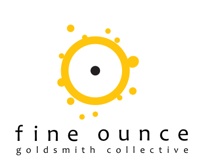One of the media
available to jewellers is vitreous enamel.
I have done very little
enamelling, but it appeals to me: the possibilities for layering, and
for variations in translucency, with completely transparent enamel
allowing light to reflect off the metal underneath, and opaque
obscuring it entirely.
Like any medium, it is
as open to use in a multitude of ways, and I don't think there can be
anyone who likes them all.
Enamel is glass that is
fused onto metal by melting (firing) it. It may be opaque or
transparent, or somewhere in between (opalescent). It is coloured by
the addition of minute amounts of elements and compounds in careful
combinations. The melting point of the glass has to be lower than
that of the metal, and the relative melting points of the various
enamels have to be taken into consideration when using more than one.
The rate and extent at which the glass contracts as it cools has to
be as close as possible to that of the metal it is fused to.


It is quite a demanding
medium. It is relatively easy to enamel something flat in one colour,
but every variation after that makes it more difficult. Most enamels
are built up of numerous layers, each fired before the next is added.
 |
| Details of Japanese enameled vessels from the collection of Stephen W.Fischer. |
Enameling started many
centuries ago, and examples are found from Mycenae and Egypt. In the
last few decades of the 19
th century and the first few of
the 20
th centuty Japan produced enamelled objects, mostly
vessels, of extraordinary virtuosity, and at about the same time Art
Nouveau and Art Deco jewellers in the West used it widely and with
great skill. One the most famous artists from this time was Rene
Lalique, in France.
 |
| Two of Lalique's magnificent pieces |
|
|
|
|
 |
| Fetish pin by William Harper |
 |
| Pendant by William Harper |
A contemporary artist
well known in the USA for his work in enamel is William Harper. He
uses brilliant and complex arrangements of colour and texture, and
incorporates stones, pearls and other materials in very interesting
ways. His work is evocative of artifacts with esoteric purposes.
 |
| Pin by Jamie Bennet |
Another prominent
American in the field is Jamie Bennet, whose experimental enameling
on three dimensional electroformed shapes attracted much attention.
 |
| Pin by Jamie Bennet |
Although vitreous
enamel is increasingly being replaced by "cold enamel"
(actually epoxy resin) in commercial jewellery, because it is so much
easier and less risky, contemporary enamel seems to be thriving in
Europe and the USA.
 |
| Rattle Brooch by Angela Gerhard |
 |
| Jessica Calderwood |
 |
| Montse Basora |
 |
| Ruth Ball Design |
 |
| Sandra Zilker |
Appreciation of it in
South Africa appears to be limited at present, but with growing
awareness of art and design, that could change.















